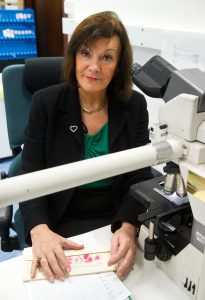Interview with Professor Mary Sheppard

When and why did you get started in pathology?
I started in pathology because my professor at medical school was a superb teacher who transferred his knowledge and love of the subject to me. I also loved looking down a microscope at the images generated by examining human tissue for evidence of disease. As you may know, most diagnoses of cancer during life are made by pathologists which determines treatment and prognosis. Therefore, pathology is a very important subject in medicine. Many members of the public do not appreciate the importance of pathology in everyday life and particularly within NHS hospitals.
What are some of your biggest achievements so far?
Setting up a department of cardiac pathology which leads research into the cardiac causes of sudden death, both nationally and internationally. We have established a worldwide reputation in this field with publications in leading medical journals. Pathologists throughout the United Kingdom respect the service that we provide to them free of charge, with a quality report delivered within two weeks of receiving the sudden cardiac death case. We have co-operated with our European and American colleagues and established international guidelines for the investigation of sudden cardiac deaths. We also provide international guidelines that help pathologists diagnose the causes of sudden cardiac death. We act as a teaching centre as well, training future pathologists in cardiac pathology. Pathologists come from all over the world to learn about cardiac pathology in our department.
How does your work support families looking for more certainty following a sudden cardiac death?
Our work is a vital link for families who are looking for a cause of death in a loved one who has suffered a sudden cardiac death. Pathologists are very busy people working within the NHS and have little time to devote to autopsy work. We offer a free service to these pathologists who have such a case of sudden cardiac death. We offer to examine the heart in detail, take tissue samples, and also accept the genetic material for storage here for future genetic testing on a national basis. Pathologists throughout the United Kingdom use this national service that CRY funding provides. I will always provide a cause of death to the family working together with the pathologist who refers the case, as well as the coroner who is handling the case locally. We guarantee to provide an answer within two weeks of getting the case. We provide the cause of death in this timeframe and avoid anxiety and uncertainty at a very stressful time for the family.
How does your research help further family screenings take place?
After somebody dies following a cardiac arrest, an autopsy is performed to determine the cause of death and this is done by a pathologist. The pathologist takes very small pieces of tissue from the body to determine the cause of death. This tissue is very important and we retain it for research. In addition, a small piece of tissue is taken for genetic analysis which also helps in determining the cause of death. We are all aware that the majority of causes of sudden cardiac death are genetic and that the family will need screening. A good post-mortem report produced when there has been a tragic sudden cardiac death is vitally important information for the cardiologist who is screening the family. Here at St George’s Hospital, I work very closely as a cardiac pathologist with the cardiologists who are screening the families who suffer a sudden young cardiac death. Determining a specific cause of the cardiac death helps the cardiologists with the screening protocol when the family visits. The cardiologists consider a good autopsy or post mortem report with histology and the genetic material being stored as vital information combined with a detailed family history in helping them make a diagnosis within the family.
How does your work support CRY’s other research, such as the recent NEJM paper on the outcomes of screening in adolescent footballers by Dr Aneil Malhotra?
Our work supports this research in providing the causes of death of the athletes who have been screened in the CRY programme. Obviously it is very important for the cardiologists to know the cardiac causes, so that they can review their screening protocols and improve diagnosis to avoid future sudden deaths in athletes.
Looking forward, what do you hope to achieve and focus on in your research?
In my research I am helping to improve the specific diagnosis in important cardiac diseases such as cardiomyopathies and channelopathies. I have established new disease entities such as idiopathic hypertrophy/enlargement of the heart. I am providing genetic material to look at genetic mutations in families who suffer a sudden cardiac death. I am looking at new markers to help pathologists make a more specific diagnosis in a sudden cardiac death case. I am also looking at the electrical activity within the heart with examination of the nerves that control the heart rate. I am also helping my cardiological colleagues with imaging techniques in cardiac disease and comparing them to the causes found at autopsy.
Do you foresee changes to how the Pathology Centre functions due to new developments or technology?
Yes, I foresee that we will be able to examine cases over the Internet, avoiding transport costs and delays when a sudden cardiac death occurs. We will be able to use imaging techniques and scanning that will enable us to see cases from throughout the world. We will be able to form an international network comparing cases from the UK and elsewhere which will help us to determine the causes throughout the world. Pathologists will be able to help each other with these high-resolution scanning techniques and use online video conferencing, enabling pathologists to discuss difficult challenging cases.




